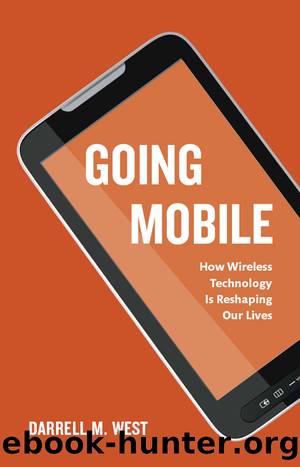Going Mobile by Darrell M. West

Author:Darrell M. West
Language: eng
Format: epub
Publisher: Brookings Institution Press
7 MEDICAL DEVICES AND SENSORS
HEALTH CARE ACCESS, AFFORDABILITY, and quality are problems the world over. There are well-established disparities based on income and geography, and the high costs of health care present affordability challenges for millions of people. Large numbers of individuals do not receive the quality care they need.
Mobile technology offers ways to help with these challenges. Through mobile health applications, sensors, medical devices, and remote patient monitoring products, avenues for improving health care delivery exist. These technologies can help lower costs by facilitating the delivery of care and connecting people to their health care providers. Applications allow both patients and providers to have access to reference materials, laboratory test results, and medical records using mobile devices.
Complex mobile health applications are useful in such areas as training health care workers, managing chronic disease, and monitoring critical health indicators. They enable easy access to tools such as calorie counters, appointment notices, medical references, and physician or hospital locators. These applications empower patients and health providers to address medical conditions proactively, through near real-time monitoring and treatment, no matter the location of the patient or provider.
In this chapter, I look at specific applications and inventions and discuss how mobile technology is transforming health care in the United States and around the world. I propose that mobile health care devices and applications help front-line health care workers and care providers be more efficient and effective in their provision of medical assistance. Finally, I recommend several steps to speed the adoption of mobile technology in health care.1
Innovations in Mobile Health Care
The health care area is undergoing a technology revolution. New services are being offered online, and consumers can use mobile phones to connect to a variety of different providers. For example, applications such as the iWander app for Android devices are being used for patients with Alzheimer's disease or dementia. People use the GPS function of smartphones to track patient locations. If the individual travels away from home or other known locations, it triggers a signal to the person's family or caretaker to check on the individual's status. Through geolocation coordinates, the person can easily be found and returned to the care setting.2
Social media sites are also helping patients cope with specific diseases. For example, diabetes-related complications represent a major source of emergency room visits. A study on the TuDiabetes.org site asked patients to report their experience with hypoglycemic events, age, gender, use of insulin pumps, and health issues. On average, the approximately 500 respondents reported experiencing six insulin-related problems.3 By sharing experiences, viewers could see what others had experienced and learn ways to cope with particular health emergencies.
Some of these applications have been developed for the cloud, which bypasses issues of compatibility of devices and apps across platforms. Interoperability challenges in the health care field manifest in numerous ways. In some cases information systems are not able to communicate with one another. At other times there are incompatibilities in terms of data files, semantics, or file-sharing protocols. Placing the wireless solution on
Download
This site does not store any files on its server. We only index and link to content provided by other sites. Please contact the content providers to delete copyright contents if any and email us, we'll remove relevant links or contents immediately.
Exploring Deepfakes by Bryan Lyon and Matt Tora(8348)
Robo-Advisor with Python by Aki Ranin(8294)
Offensive Shellcode from Scratch by Rishalin Pillay(6416)
Microsoft 365 and SharePoint Online Cookbook by Gaurav Mahajan Sudeep Ghatak Nate Chamberlain Scott Brewster(5667)
Ego Is the Enemy by Ryan Holiday(5348)
Management Strategies for the Cloud Revolution: How Cloud Computing Is Transforming Business and Why You Can't Afford to Be Left Behind by Charles Babcock(4546)
Python for ArcGIS Pro by Silas Toms Bill Parker(4494)
Machine Learning at Scale with H2O by Gregory Keys | David Whiting(4260)
Elevating React Web Development with Gatsby by Samuel Larsen-Disney(4212)
Liar's Poker by Michael Lewis(3416)
Learning C# by Developing Games with Unity 2021 by Harrison Ferrone(3344)
Speed Up Your Python with Rust by Maxwell Flitton(3298)
OPNsense Beginner to Professional by Julio Cesar Bueno de Camargo(3262)
Extreme DAX by Michiel Rozema & Henk Vlootman(3248)
Agile Security Operations by Hinne Hettema(3169)
Linux Command Line and Shell Scripting Techniques by Vedran Dakic and Jasmin Redzepagic(3160)
Essential Cryptography for JavaScript Developers by Alessandro Segala(3130)
Cryptography Algorithms by Massimo Bertaccini(3071)
AI-Powered Commerce by Andy Pandharikar & Frederik Bussler(3035)
